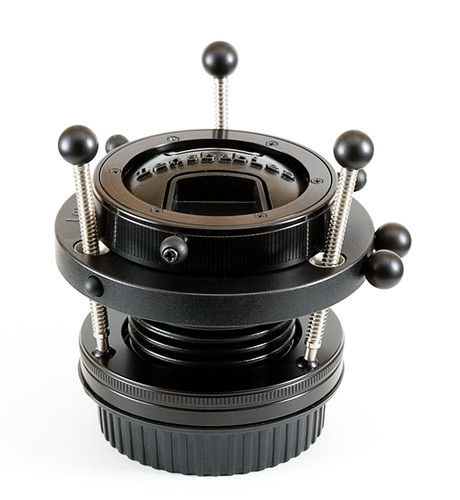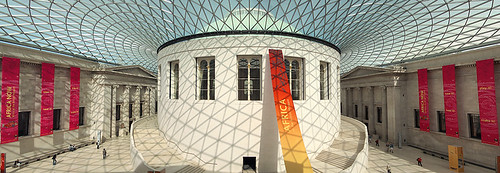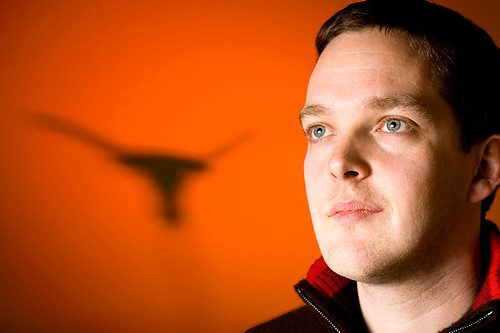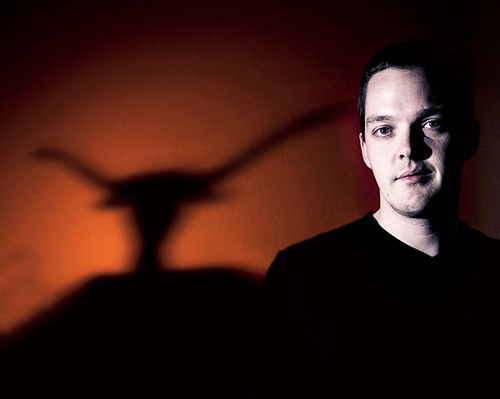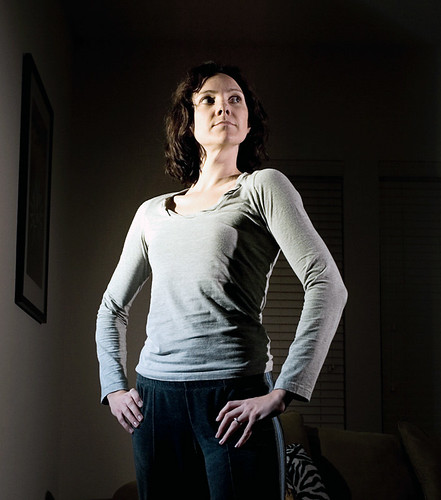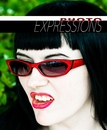
A couple of people have commented on how lucky I am to have so many subjects willing to pose for me. I agree. I have wonderful friends.
But the reality is that I also put quite a bit of effort in up front to make these shoots go quickly and appear simple and effortless. Most of the actual shoots are brief - 5 or 10 minutes per person is what I'm aiming for. I don't want to intrude beyond that. But prior to that there is often a week or more of email, discussion and cajoling that goes on. In some cases, the 5 or 10 minutes of shooting took two months from asking if I could take the picture to actually getting together to shoot it.
I think many people only ever have had their portraits done in the assembly line of school pictures or perhaps in the mayhem of their wedding day. So when I first ask if I can take someone's picture, there's all those 'fun' experiences that flashes into their head. So I need to get beyond that barrier and explain what I'm wanting to to - why I want to take their picture. Also, the majority of people are just shy about having their picture taken, lots of perfectly normal doubts and insecurities surface - it all seems much more formal than a quick snap at a party. I suspect most people are secretly flattered to be asked, but there is also usually a lot of questions or reticence about it. I show samples of what I've been doing (which is getting easier now that I have actually got more samples to show). Having a web site with the images on it helps a lot too. I can point people right at what the pictures will look like. I try to answer the questions or put the fears to rest. So far nobody has turned me down - though that's also fine if someone isn't interested. Nobody has to take part!
The other thing that pays off big time is asking more than once. That follow-through or persistence seems to count. People take you more seriously if you actually set up a date and try to schedule it in somewhere. It also gives them time to mentally prepare, to be in the right place and be ready to give you 10 minutes of their time, rather than just springing it from nowhere, with a camera in hand. I usually try to give some guidance about clothes or at least general styles that will work and we try to pick a time when the light should be good.
Before I turn up, I try to think through where I want to shoot. I'm lucky for this project because part of the aim is to shoot in familiar places - people's homes, or spaces that we spend a lot of time in. So I usually have some idea of what the location will be like. I'm thinking ahead for good windows facing away from the sun for even, easy to use light (such as in the shot with
Arun) or else I'm looking for something that will work well as a background in good light. For the shot with
Michelle, I saw where I wanted to shoot her about 4 hours before we actually shot there - a bright yellow wall - but when I saw it, it was in full sunlight. So I waited for the light to change and we happened to be near there that afternoon as well and I suggested we go and shoot. It took about 5 minutes total, from her perspective, but only because I'd been trying to find the right location all day.
I also spend time thinking about what poses or expressions I want to get. People very strongly reflect the mood of the photographer, so if you are high energy, the shoot will be high energy. If you are quiet, the shoot will be quiet - so I have to get into the right frame of mind for the results I want to get. I also get the camera set up so that I can pay as little attention to it as possible and spend all of the time trying to talk to the subject, interact and move towards the results I want. I'll direct a bit but not a whole lot. Often I just try to talk about something I know will engage their attention and then just watch and shoot when I see the things I want happening. I'll try to guide the conversation in the right direction but I'm really aiming to keep things natural and flowing.
The main thing I'm trying to pay attention to is the
catchlights in the eyes and how the shadows are working in the scene. I'll occasionally check that the shutter speed is fast enough or that I'm getting a good exposure on the histogram but that's all I do with the camera. I use a small, prime lens (85mm 1.8) to avoid the lens looking too big or imposing, which is intimidating. The camera is often on a tripod so my head can appear out from behind it and make some eye contact while talking. Expressions change quickly so I try to react and shoot a lot, knowing that I'll miss some shots but that I can get natural responses rather than something that is really stiff or posed.
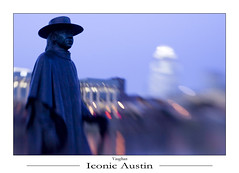 manipulate the lens to change the focus point on the frame, pushing and pulling it to focus at different distances, bending and twisting the lens to move the sweet spot around the composition, it leads to a very tactile way of shooting. Often the question is asked Why can't you just do it in Photoshop? Partly this is because the final effect of the lensbaby would be hard to achieve, but mainly the difference is doing it in Photoshop, you'd just shoot normally and consciously add blur after the fact. With a lensbaby, you do it right then and there. Reacting to the scene through the camera, not thinking so much, there is less control which leads to maybe more happy accidents but also to you doing things you'd never try in Photoshop. The results for me are just totally different. Looking through a lensbaby changes how I'd compose the scene and how I would approach the subject - something that is lost if I try to do it later.
manipulate the lens to change the focus point on the frame, pushing and pulling it to focus at different distances, bending and twisting the lens to move the sweet spot around the composition, it leads to a very tactile way of shooting. Often the question is asked Why can't you just do it in Photoshop? Partly this is because the final effect of the lensbaby would be hard to achieve, but mainly the difference is doing it in Photoshop, you'd just shoot normally and consciously add blur after the fact. With a lensbaby, you do it right then and there. Reacting to the scene through the camera, not thinking so much, there is less control which leads to maybe more happy accidents but also to you doing things you'd never try in Photoshop. The results for me are just totally different. Looking through a lensbaby changes how I'd compose the scene and how I would approach the subject - something that is lost if I try to do it later.
 The second thing I really like about a lensbaby is how it treats highlights in the out of focus areas. I'm used to round or at least regular bokeh, but if you push and bend a lensbaby enough you get elliptical bokeh which I just find fascinating, particularly on bright spots in the out of focus regions. You can see those elliptical effects in the statue image above. I'm intrigued by the idea of cutting custom aperture disks with stars or different shapes to further play with the OOF highlights. I've recently heard that Lensbaby are going to be selling custom aperture kits, star & heart shapes plus several blanks to cut your own. This effect is particularly attractive for city night photography - lots of point light sources that render the aperture shape when out of focus.
Compositionally, I find a couple of good or common uses for the lensbaby The first ways it gets used is to control confusion. Many fans of the lens use it for street portraiture, where the backgrounds or edges of the frame might well be chaotic. The lensbaby helps here by throwing those regions out of focus and helps you pay attention to the subject. The build in focus vignetting allows the photographer to worry about the subject and expect everything else to just blur into the background.
The second thing I really like about a lensbaby is how it treats highlights in the out of focus areas. I'm used to round or at least regular bokeh, but if you push and bend a lensbaby enough you get elliptical bokeh which I just find fascinating, particularly on bright spots in the out of focus regions. You can see those elliptical effects in the statue image above. I'm intrigued by the idea of cutting custom aperture disks with stars or different shapes to further play with the OOF highlights. I've recently heard that Lensbaby are going to be selling custom aperture kits, star & heart shapes plus several blanks to cut your own. This effect is particularly attractive for city night photography - lots of point light sources that render the aperture shape when out of focus.
Compositionally, I find a couple of good or common uses for the lensbaby The first ways it gets used is to control confusion. Many fans of the lens use it for street portraiture, where the backgrounds or edges of the frame might well be chaotic. The lensbaby helps here by throwing those regions out of focus and helps you pay attention to the subject. The build in focus vignetting allows the photographer to worry about the subject and expect everything else to just blur into the background.
 Something I'm finding even stronger is to use it when there are specific regions that have strong design elements that I want to throw out of focus. These aren't regions that are clutter or distracting, but just sections that will retain a strong compositional element when out of focus. Examples of this are the strongly coloured, stripped shirt or the person at the edge of the pool. In both cases, the selective focus doesn't diminish the contribution of those regions. The person is still recogniseable, the stripes and colours of the shirt are still part of the composition; but the softening of focus strengthens their contribution as elements of design. They become more abstract and act as powerful framing elements.
The fish portrait of Amanda is another example of consciously using the lens blur to focus on her face; not to control any confusing elements from the fish but more to turn it into a stronger design element of the scene. The leading lines and colour becomes even more relevant with the selective focus, rather than being hidden or removed from the scene by the blur.
Something I'm finding even stronger is to use it when there are specific regions that have strong design elements that I want to throw out of focus. These aren't regions that are clutter or distracting, but just sections that will retain a strong compositional element when out of focus. Examples of this are the strongly coloured, stripped shirt or the person at the edge of the pool. In both cases, the selective focus doesn't diminish the contribution of those regions. The person is still recogniseable, the stripes and colours of the shirt are still part of the composition; but the softening of focus strengthens their contribution as elements of design. They become more abstract and act as powerful framing elements.
The fish portrait of Amanda is another example of consciously using the lens blur to focus on her face; not to control any confusing elements from the fish but more to turn it into a stronger design element of the scene. The leading lines and colour becomes even more relevant with the selective focus, rather than being hidden or removed from the scene by the blur.
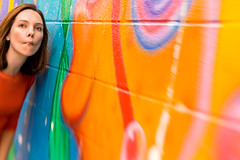 One initial problem I had with the lensbaby was trying to shoot it wide open. The lens without any aperture rings is around f2.0 which gives a very narrow depth of field for this ~50mm focal length lens. When I started using f4 or f5.6 rings to practice I started getting more frames where something was in focus! It is also difficult with a second generation lensbaby to push the sweet spot too far to the edge of the frame. It is possible but you do start to get to a point where nothing is in focus at all. The 3G lensbaby is easier to distort even more in this respect, due to the fine focus controls and ability to fix the bend and then move the camera around.
All of the shots on this page were taken with a 2G lensbaby. I'm just starting to explore the possibilities that the 3G provides. I can see it being usable for self portraits because of the fixable lens flex, usable for landscapes because of the smaller aperture disks, more usable for studio portraiture given the repeatability inherent in fixing the lens and perhaps also for HDR and other types of photography that require multiple exposures of the same scene. I've already shot a few self-portraits with the 3G lensbaby and tried some night photography. It isn't easy manually focusing in the near dark!
One initial problem I had with the lensbaby was trying to shoot it wide open. The lens without any aperture rings is around f2.0 which gives a very narrow depth of field for this ~50mm focal length lens. When I started using f4 or f5.6 rings to practice I started getting more frames where something was in focus! It is also difficult with a second generation lensbaby to push the sweet spot too far to the edge of the frame. It is possible but you do start to get to a point where nothing is in focus at all. The 3G lensbaby is easier to distort even more in this respect, due to the fine focus controls and ability to fix the bend and then move the camera around.
All of the shots on this page were taken with a 2G lensbaby. I'm just starting to explore the possibilities that the 3G provides. I can see it being usable for self portraits because of the fixable lens flex, usable for landscapes because of the smaller aperture disks, more usable for studio portraiture given the repeatability inherent in fixing the lens and perhaps also for HDR and other types of photography that require multiple exposures of the same scene. I've already shot a few self-portraits with the 3G lensbaby and tried some night photography. It isn't easy manually focusing in the near dark!

